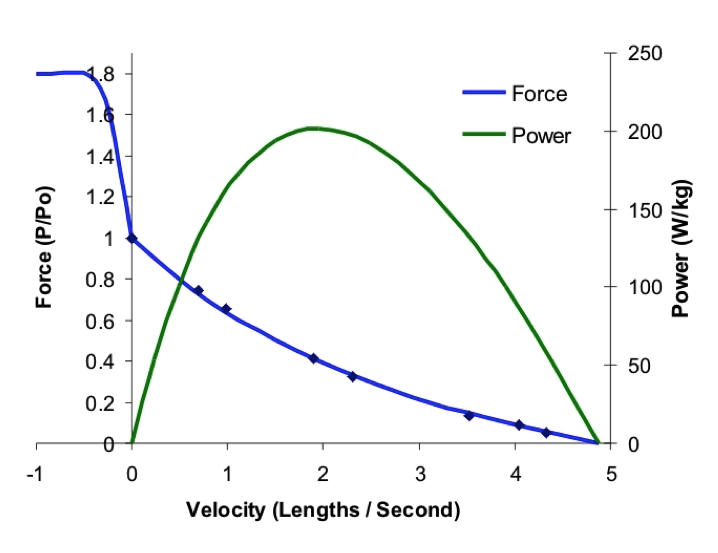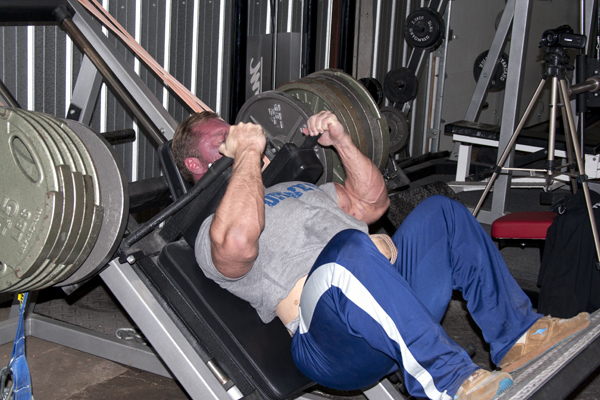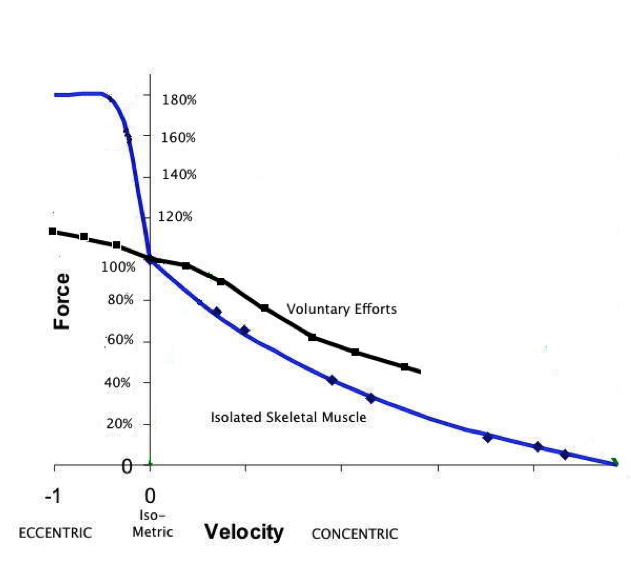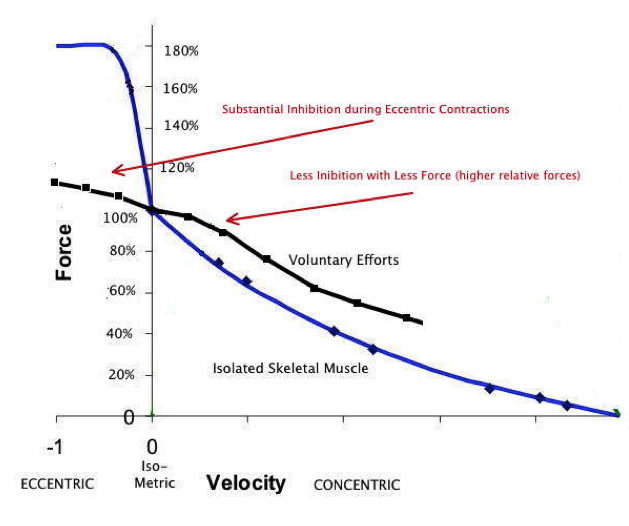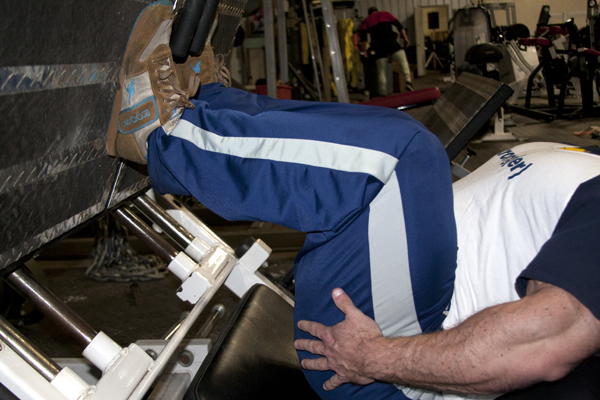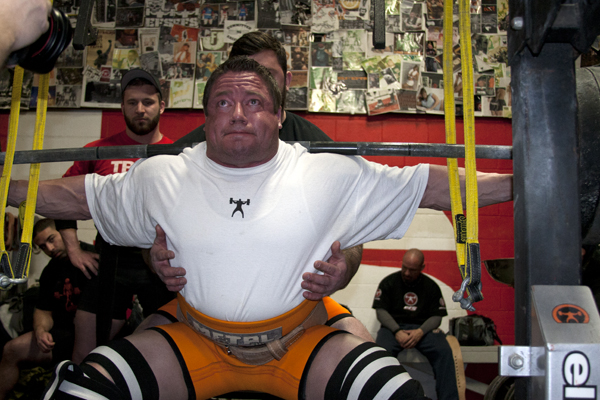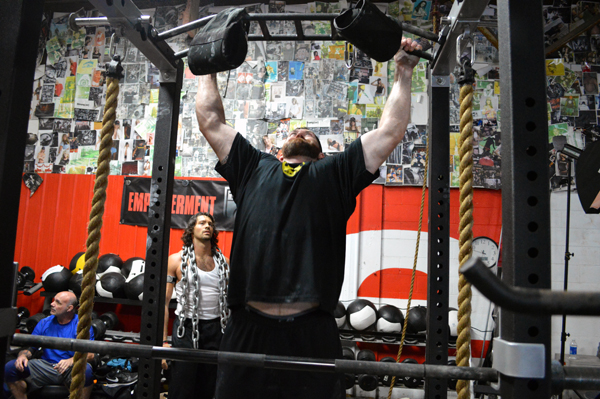
Eccentric-oriented movements are a powerful way to spice up your training and bolster gains.
Scientia potential est.
Knowledge is power.
I learned this unexpectedly years ago when I was given the opportunity to teach anatomy and physiology in graduate school. Although I’d been training for 15 years already, my new-found anatomical insights had a dramatic impact on my ability to create new exercises, find new twists on old exercises, and to feel exercises “in the right place.” Expanding my academic knowledge resulted in hands-on insights in the gym that I might not have otherwise had.
I’d like to help you do the same. In this case, the topic will be muscle physiology — how muscle functions at a basic level. In particular, I will talk about muscle physiology during eccentric (lengthening) contractions.
Eccentrics in Isolation
A casual Google search for “the force velocity curve,” turns up a number of articles, both academic and sports training related, but little discussion of the “left side” of the curve (see Figure 1), where velocity values are negatives. In a force-velocity curve like this one, “negative velocity” of shortening means lengthening, i.e., skeletal muscle is contracting (producing force) but being forced to lengthen (in the lab) at various speeds.
The first extensive scientific report of these kinds of phenomena appeared in the late 30’s when A. V. Hill described an apparatus he invented for testing the mechanical properties of frog muscle during shortening, isometric, and lengthening contractions (1). Nowadays, the same thing can be done using an isokinetic dynamometer (much stronger than any human, even all of you reading this). With this apparatus, subjects push (or pull) against or resist the lever arm of the machine while it moves at pre-set speeds and in different direction. Figure 1 is a generic depiction of the (hyperbolic) force-velocity relationships for isolated skeletal muscle (artificially stimulated to contract).
Figure 1: Generic Depiction of the Force-Velocity and Force-Power Curves of Isolated Skeletal Muscle. [Figure By Mokele (talk).HCA at en.wikipedia. Later version(s) were uploaded by Gciriani at en.wikipedia. [Public domain], from Wikimedia Commons.]
As you can see from the abbreviated left side of the curve in this generic figure, eccentric contractions are barely given attention. The majority of the plot depicts concentric (shortening) contractions. Before turning our attention to eccentric, make note that peak power (the green curve) is found at velocities of about 40% of the maximum (where P / Po equals 1). If you find the velocity on the force (blue) that corresponds to the peak on the power (green) curve (about two lengths per second), you can see that this occurs at about 0.4 (40 percent) of maximal force. This agrees well with A. V. Hill’s original data, which suggested that max concentric power was produced at forces equivalent to 30 percent of maximal isometric tension.
For intact, living, breathing people, peak power has actually been found to occur at a wide range of loads, depending on how it was tested (2). While some standardized tests of power for bench press and squats using 30 percent of the subjects one rep max are reliable (3), the relative loads to optimize upper and lower body peak power may be substantially different, and even as high as 60 to 70 percent of the one rep max for lower body actions (4).
Why the difference? Voluntary muscle performance is a matter of both muscular capability and neutral control. Neural control generally limits the amount of force and power an individual can produce (5).
Bottom line: Even with maximal voluntary efforts, muscle force production differs from the unadulterated performance of isolated skeletal muscle.
Eccentrics in Real Life: Easy Stuff
Let’s take a step back. If contracting a muscle eccentrically is inherently stronger than concentrically contracting muscle, how can we possibly lower a weight using the same muscle we used to lift it? Wouldn’t the force simply go up once the muscle is lengthened, making it impossible to lower the load in the first place?
The answer is simple: activating less (much less) muscle will allow it to contract while lengthening under load. Just as it is easier to walk down a hill than to climb it, it is easier to lower a load than to lift it. In fact, eccentric contractions are a lot “easier” and energy intensive than you might expect. When doing leg press (four sets of 7-10 reps to failure), lowering the loads (sometimes called “negatives work”) only adds about 14 percent to the energy cost of lifting the weight (11).
In one study that used an isokinetic dynamometer, there was no significant fatigue over the course of four sets of 32 maximal eccentric only repetitions. Neither force nor electrical activity (indicative of level of activation) changed rep by rep or set by set (12). From a metabolic perspective, all-out eccentrics are easy.
Bottom line: The force production capabilities and energetic advantages of eccentric contractions call for less muscle use when lowering loads.
Eccentric Strength is Limited
We’re hard-wired to use less muscle when lowering loads, simply because, in most circumstances, less muscle is needed. Additionally, the heavier the load and the greater the force, the more our nervous system inhibits muscle activation, e.g., via Golgi tendon organs, to prevent injury (13, 14). The below figure compares force performance of isolated skeletal muscle with that during voluntary contractions (7, 15).
Figure 2: Based on Figure 1, incorporating voluntary muscle performance data from two studies(7, 15).
It’s been known for at least 50 years that muscle electrical activity is reduced during eccentric actions (10). This can be seen most clearly during maximal eccentric efforts. An EMG study of national and international caliber UK strength and power athletes estimated that eccentric strength could be increased nearly 60 percent with the elimination of inhibitory neural factors (16). As you might expect, the extent of inhibition depends upon training status as well (17). From figure 2 (above) and 3 (below), you’ll notice:
- The eccentric side of the force curve is relatively flat (18) for both voluntary and isolated muscle, suggesting inhibition is maintained as lengthening speeds increase.
- Some degree of inhibition is simply a matter of force production. Even slow concentric contractions result in a deviation from A.V. Hills classical curve, in scenarios ranging from simple knee extensions in untrained individuals (19) to dynamic squats in the resistance trained subjects (20). However, the extent of inhibition during slow concentric actions may have been overestimated by some (21).
Figure 3: The high forces of maximal eccentric(18) and slow concentric(19-21) contractions suggestion inhibition with voluntary efforts (Based on Figures 1 and 2, incorporating data from two studies(7, 15).)
Bottom Line: Neural inhibition limits eccentric and high load concentric strength, but dis-inhibition (reduction of inhibition) is trainable (5, 13, 22).
Eccentrics are Unnatural?
As I’ve noted previously, the act of repeatedly raising and lowering the same load in the same place may be a bit out of place in the context of essential activities of daily life. Some might even call resistance training an “unnatural” act in that sense. However, as with developing a callus or sunburn in response to a mechanical or electromagnetic threat, we obviously have tremendous capacity to adapt to modern weight training regimes.
Indeed, the most salient feature of a typical strength or bodybuilding routine (heavy loading of skeletal muscle) is epitomized by eccentric contractions. Heavy eccentric loading is a double-edged sword, though. Eccentric contractions invoke more muscle damage than concentric or isometric actions (23), and they are also energetically inexpensive, so you can do a lot of them without the limitations of metabolic fatigue (12). In the gym, this is why one can prolong a set using forced reps, even after reaching positive (concentric) momentary muscular failure. Nonetheless, eccentrically-induced cellular perturbations may be important for triggering muscle growth (24, 25).
Two sets of rat studies effectively isolated the effects of loading and contraction type from fatigue and metabolic stress (26, 27). In these studies, eccentrically trained (heavily-loaded) muscles grew, whereas low load concentric contractions failed to increase muscle size (28-30). Recent research suggests what gym rats have known for decades: loading in and of itself is an independently transduced signal for muscle growth (31-33), and this is especially true for eccentric contractions (34).
When it comes to leg press (dynamic “isotonic”) exercise, leaving out the lowering (eccentric) portion of each repetition produces inferior muscle strength (three repetition maximum) (35) and size gains (36). Even doing twice as many sets of concentric-only repetitions does not compensate for leaving out the lowering contractions. Similarly, isokinetic training (where effort is maximal during each rep, while speed is controlled) demonstrates the superiority of eccentric-only over concentric-only exercise in terms of muscle size. However, specificity of training prevails: eccentric training is superior for eccentric strength and concentric training produces better strength gains during concentric efforts (37).
One of the rat studies mentioned above pointed out that too much of a good thing can be bad. The highest frequency eccentric training regime (training every other day) failed to increase muscle mass (30). Note that these contractions were maximal and supraphysiological, as they were evoked by electrical stimulation. An extensive review of the literature of Wernborn concluded similarly that when training volume is low, maximal eccentric efforts are more effective than maximal concentric-only training for increasing muscle size (38).
Bottom Line: Eccentric contractions constitute an important component of the loading stimulus for muscle growth, but can be used in excess.
Real World Eccentric Training
Most of us do not have access to an isokinetic dynamometer and/or a high-powered myoelectrical stimulation unit. When used together, these can actually produce extraordinary (even supraphysiological) eccentric muscles forces and evoke muscle growth faster than training with voluntary contractions alone (39, 40). Isokinetic dynamometry permits a detailed investigation of training variables such as varying speed during maximal eccentric efforts (41) or comparison of concentric and eccentric training when power or work output is equated (42-43). The modes of training used in such studies are typically not possible with free weights or machines (although mainstream fitness equipment that overloads the eccentric action of each repetition has been produced).
In particular, attempting to apply research suggesting that maximal isokinetic eccentric training at faster speeds (41) promotes greater muscle growth to a free weight training scenario lacks external validity from a scientific standpoint. Doing so would likely result in eccentric unloading (due to the momentum when attempting to rapidly lower a barbell or dumbbell) or increased injury potential if a spotter were to apply downward force during high-speed eccentric contractions.
Naturally, controlling the eccentric action during a normal repetition makes sense if you want to maintain eccentric tension. Additionally, after a momentum-minimized eccentric, a controlled, safe, explosive concentric may improve power production and reduce fatigue, i.e., via stretch shortening strategy (44, 45) that permits faster concentric actions and thus more repetitions with a given load (46).
There are, however, several practical techniques of exploiting the eccentric. Most of these should be used with caution and only in advanced trainees. As noted above, increasing muscle force with eccentric actions should be used sparingly due to the potential to create more muscle disruption than desired. Here are several eccentric-focused weight-training techniques that can be employed in most commercial gyms:
Two Up/One Down
Using bilateral machines (e.g., a leg press or chest press), raise the load with both limbs and lower with only one limb. This will limit fatigue and thus allow one to accumulate more eccentric contractions. These can be done with dumbbells as well, e.g., using one arm to assist on the way up during a concentration curl. Eccentric one-arm pushups can be done this way, too, by pressing up with both arms, and lowering with one.
Forced Eccentrics (Forced Negatives)
These are most safely done in a fatigued state with lighter loads. For example, as one reaches concentric failure at the end of a drop set, the spotter helps lift the load and provides enough additional load during the eccentric contraction such that the lowering tempo is normal or even slower. A similar technique that John Meadows uses is called “isotension,” where isometric contractions are performed with extra tension provided by a spotter.
Cheat Repetitions
As with Forced Eccentrics, Cheat Repetitions should also be employed with caution. Using safe, and limited “body English” to assist with the concentric (lifting) of a weight, the set is prolonged by doing slow, controlled eccentric contractions. This technique is often considered poor form by most, but has a solid physiological rationale as pointed out in this article. If you are unfamiliar with the technique used in power cleans or other compound or dynamic whole body movements (squats, deadlift, push presses, etc.), especially those which protect the low back, you are likely not a good candidate for safely using body English to do Cheat Repetitions.
Special Exercises
Some exercises lend themselves to eccentric only training. These would include:
- Eccentric Chin or Pull-Up: Use a chin bar (and/or step) setup so you can start at the top of the motion and simply lower yourself eccentrically.
- Natural Glute-Ham Raise, aka Nordic Hamstring Curl, aka (Assisted) Russian Knee Curl: In a prone position with the ankles secured, a dynamic “push-up” assists concentrically and one lowers the body (eccentric hamstring contractions) by controlled knee extension, minimizing movement at the hip and low back (hips and back are locked in place). NOTE: This requires substantial hamstring strength relative to body weight.
- Eccentric Wrist Curls: Perform barbell wrist curls with the bar or dumbbells supported at a level to allow you so stand up with the load in a wrist and finger flexed position (weight at the top of the range of motion) and lower the weight eccentrically to the starting position.
Cluster Sets With Eccentric Focus
Cluster sets consist of a series of repetitions interspersed by a very short (~5-30sec) rest interval (47). A famous contemporary example is a DC Training style “rest–pause” set. Using a partner to assist in raising the weight to the starting point, one begins each series of repetitions with an eccentric (lowering contraction) and finishes the set (after concentric failure or as the last rep performed) with an eccentric contraction to a safe stopping point. In doing so, the lifter can accumulate several more eccentric contractions over the course of a multi-series cluster set.
Add Spice, in the Right Amount
As a final reminder, eccentric training can indeed be used in excess of one’s recovery abilities. Don’t overdo it. Also, the higher forces relatives to activated muscle may explain why eccentric actions are quite commonly part of the mechanism of injury for tears of the quadriceps femoris (48), pectoralis major (49), and hamstring muscles (50, 51). Eccentric training may, however, reduce the risk of hamstring tears (52, 53). When employed in the right measure, the tensile overload of eccentric-focused training techniques may just be the right flavor to spice up and accelerate your training progress.
References
1. Hill, A.V., The heat of shortening and the dynamic constants of muscle. Proceedings of the Royal Society of London. Series B, Biological Sciences, 1938. 126(843): p. 136-195.
2. Cormie, P., et al., Power-time, force-time, and velocity-time curve analysis of the countermovement jump: impact of training. The Journal of Strength & Conditioning Research, 2009. 23(1): p. 177-186.
3. Comstock, B.A., et al., Validity of the Myotest® in measuring force and power production in the squat and bench press. The Journal of Strength & Conditioning Research, 2011. 25(8): p. 2293-2297.
4. Izquierdo, M., et al., Maximal strength and power characteristics in isometric and dynamic actions of the upper and lower extremities in middle-aged and older men. Acta Physiologica Scandinavica, 1999. 167: p. 57-68.
5. Ikai, M. and A.H. Steinhaus, Some factors modifying the expression of human strength. J Appl Physiol, 1961. 16: p. 157-63.
6. Holmes, J.W., Teaching from classic papers: Hill's model of muscle contraction. Adv Physiol Educ, 2006. 30(2): p. 67-72.
7. Pain, M.T.G., et al., The torque-velocity relationship in large human muscles: Maximum voluntary versus electrically stimulated behaviour. Journal of Biomechanics, 2013. 46(4): p. 645-50.
8. Katz, B., The relation between force and speed in muscular contraction. The Journal of Physiology, 1939. 96(1): p. 45.
9. Abbott, B.C., et al., The physiological cost of negative work. The Journal of physiology, 1952. 117(3): p. 380-390.
10. Bigland, B. and O.C.J. Lippold, The relation between force, velocity and integrated electrical activity in human muscles. The Journal of physiology, 1954. 123(1): p. 214-224.
11. Dudley, G.A., et al., Influence of eccentric actions on the metabolic cost of resistance exercise. Aviat Space Environ Med, 1991. 62(7): p. 678-82. http://www.ncbi.nlm.nih.gov/pubmed/1898305
12. Tesch, P.A., et al., Force and EMG signal patterns during repeated bouts of concentric or eccentric muscle actions. Acta Physiol Scand, 1990. 138: p. 263-271.
13. Sale, D.G., Neural adaptation to resistance training. Med Sci Sports Exerc, 1988. 20(5 Suppl): p. S135-45.
14. McComas, A.J., Skeletal muscle : form and function. 1996, Champaign, IL: Human Kinetics. xiv, 401 p.
15. Dudley, G.A., et al., Effect of voluntary vs. artificial activation on the relationship of muscle torque to speed. Journal of applied physiology, 1990. 69(6): p. 2215-21. http://www.ncbi.nlm.nih.gov/pubmed/2077019
16. Pain, M.T. and S.E. Forrester, Predicting maximum eccentric strength from surface EMG measurements. J Biomech, 2009. 42(11): p. 1598-603.
17. Amiridis, I.G., et al., Co-activation and tension-regulating phenomena during isokinetic knee extension in sedentary and highly skilled humans. Eur J Appl Physiol Occup Physiol, 1996. 73(1-2): p. 149-56.
18. Carney, K.R., Eccentric torque/velocity and power/velocity relationship of the elbow flexors. 2010, California State University, Fullerton: Ann Arbor. p. 36.
19. Perrine, J.J. and V.R. Edgerton, Muscle force-velocity and power-velocity relationships under isokinetic loading. Med Sci Sports, 1978. 10(3): p. 159-66.
20. Rahmani, A., et al., Force/velocity and power/velocity relationships in squat exercise. European Journal of Applied Physiology, 2001. 84(3): p. 227-32.
21. Harris, R.T. and G.A. Dudley, Factors limiting force during slow, shortening actions of the quadriceps femoris muscle group in vivo. Acta Physiol Scand, 1994. 152(1): p. 63-71.
22. Sale, D.G., Neural adaptation in strength and power training, in Human Muscle Power, N.L. Jones, N. McCartney, and A.J. McComas, Editors. 1986, Human Kinetics Publishers: Champaign. p. 289-307.
23. Kuipers, H., Exercise-induced muscle damage. Int.J Sports Med, 1994. 15: p. 132-135.
24. Evans, W.J. and J.G. Cannon, The metabolic effects of exercise-induced muscle damage. Exerc Sport Sci Rev, 1991. 19: p. 99-125.
25. Schoenfeld, B.J., Does exercise-induced muscle damage play a role in skeletal muscle hypertrophy? Journal of strength and conditioning research / National Strength & Conditioning Association, 2012. 26(5): p. 1441-53. http://www.ncbi.nlm.nih.gov/pubmed/22344059
26. Schoenfeld, B.J., Potential Mechanisms for a Role of Metabolic Stress in Hypertrophic Adaptations to Resistance Training. Sports medicine, 2013. 43(3): p. 179-94. http://www.ncbi.nlm.nih.gov/pubmed/23338987
27. Loenneke, J.P., Skeletal muscle hypertrophy: How important is exercise intensity. Journal of Trainology, 2012. 1(2): p. 28-31. http://trainology.org/PDF/6%20Skeletal%20Muscle%20Hypertrophy%20How%20important%20is%20Exercise%20Intensity.%20Loenneke.pdf
28. Baar, K. and K. Esser, Phosphorylation of p70(S6k) correlates with increased skeletal muscle mass following resistance exercise. Am J Physiol, 1999. 276(1 Pt 1): p. C120-7. http://www.ncbi.nlm.nih.gov/pubmed/9886927
29. Wong, T.S. and F.W. Booth, Protein metabolism in rat tibialis anterior muscle after stimulated chronic eccentric exercise. J Appl Physiol (1985), 1990. 69(5): p. 1718-24.
30. Wong, T.S. and F.W. Booth, Protein metabolism in rat gastrocnemius muscle after stimulated chronic concentric exercise. J Appl Physiol (1985), 1990. 69(5): p. 1709-17.
31. Hornberger, T.A., Mechanotransduction and the regulation of mTORC1 signaling in skeletal muscle. The international journal of biochemistry & cell biology, 2011. 43(9): p. 1267-76. http://www.ncbi.nlm.nih.gov/pubmed/21621634
32. Hornberger, T.A., et al., The role of phospholipase D and phosphatidic acid in the mechanical activation of mTOR signaling in skeletal muscle. Proceedings of the National Academy of Sciences of the United States of America, 2006. 103(12): p. 4741-6. http://www.ncbi.nlm.nih.gov/pubmed/16537399
33. Hornberger, T.A., et al., Mechanical stimuli regulate rapamycin-sensitive signalling by a phosphoinositide 3-kinase-, protein kinase B- and growth factor-independent mechanism. The Biochemical journal, 2004. 380(Pt 3): p. 795-804. http://www.ncbi.nlm.nih.gov/pubmed/15030312
34. O'Neil, T.K., et al., The role of phosphoinositide 3-kinase and phosphatidic acid in the regulation of mammalian target of rapamycin following eccentric contractions. J Physiol, 2009. 587(Pt 14): p. 3691-701. http://www.ncbi.nlm.nih.gov/pubmed/19470781
35. Hather, B.M., et al., Influence of eccentric actions on skeletal muscle adaptations to resistance training. Acta Physiol Scand, 1991. 143(2): p. 177-85.
36. Dudley, G.A., et al., Importance of eccentric actions in performance adaptations to resistance training. Aviation, space, and environmental medicine, 1991. 62(6): p. 543-50. http://www.ncbi.nlm.nih.gov/pubmed/1859341
37. Higbie, E.J., et al., Effects of concentric and eccentric training on muscle strength, cross-sectional area, and neural activation. J Appl Physiol (1985), 1996. 81(5): p. 2173-81.
38. Wernbom, M., et al., The influence of frequency, intensity, volume and mode of strength training on whole muscle cross-sectional area in humans. Sports Med, 2007. 37(3): p. 225-64. http://www.ncbi.nlm.nih.gov/pubmed/17326698
39. Ruther, C.L., et al., Hypertrophy, resistance training, and the nature of skeletal muscle activation. J.Strength Cond.Res., 1995. 9: p. 155-159.
40. Stevenson, S.W. and G.A. Dudley, Dietary creatine supplementation and muscular adaptation to resistive overload. Medicine and science in sports and exercise, 2001. 33(8): p. 1304-10. http://www.ncbi.nlm.nih.gov/pubmed/11474331
41. Farthing, J.P. and P.D. Chilibeck, The effects of eccentric and concentric training at different velocities on muscle hypertrophy. Eur J Appl Physiol, 2003. 89(6): p. 578-86.
42. Mayhew, T.P., et al., Muscular adaptation to concentric and eccentric exercise at equal power levels. Med Sci.Sports Exerc., 1995. 27: p. 868-873.
43. Guilhem, G., et al., Neuromuscular adaptations to isoload versus isokinetic eccentric resistance training. Med Sci Sports Exerc, 2013. 45(2): p. 326-35.
44. Doan, B.K., et al., Effects of increased eccentric loading on bench press 1RM. J Strength Cond Res, 2002. 16(1): p. 9-13.
45. Komi, P.V. and C. Nicol, Stretch–shortening cycle of muscle function. Neuromuscular aspects of sport performance, 1st edn. Wiley-Blackwell, Chichester, 2010: p. 15-31.
46. Sakamoto, A. and P.J. Sinclair, Effect of movement velocity on the relationship between training load and the number of repetitions of bench press. J Strength Cond Res, 2006. 20(3): p. 523-7.
47. Haff, G.G., et al., Cluster training: A novel method for introducing training program variation. Strength Cond. J., 2008. 30: p. 67-76.
48. Boublik, M., et al., Quadriceps tendon injuries in national football league players. Am J Sports Med, 2013. 41(8): p. 1841-6.
49. Dodds, S.D. and S.W. Wolfe, Injuries to the pectoralis major. Sports Medicine, 2002. 32(14): p. 945-952.
50. Kujala, U.M., et al., Hamstring injuries. Sports Medicine, 1997. 23(6): p. 397-404.
51. Brockett, C.L., et al., Predicting hamstring strain injury in elite athletes. Medicine & Science in Sports & Exercise, 2004. 36(3): p. 379-387.
52. Askling, C., et al., Hamstring injury occurrence in elite soccer players after preseason strength training with eccentric overload. Scandinavian journal of medicine & science in sports, 2003. 13(4): p. 244-250.
53. Sayers, A. and B.-E. Sayers, The Nordic Eccentric Hamstring Exercise for Injury Prevention in Soccer Players. Strength and Conditioning Journal, 2008. 30(4): p. 56-58.









